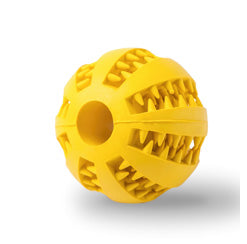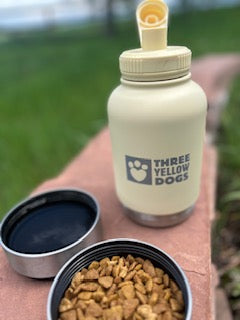Winter has arrived, and the chill is palpable, especially where I call home—it's downright freezing. Typically, the weather here stays below freezing for months on end! Despite the frigid conditions, my family relishes spending ample time outdoors. We bundle up in warm socks, base layers, jackets, hats, gloves, and boots, ensuring we're adequately prepared and comfortable. However, a recent occurrence gave me pause: my husband's nose began peeling and it had a slight discoloration. Could he have possibly suffered from frostbite amidst Old Man Winter's harsh embrace? Fortunately, his nose recovered, but it prompted me to think about our dogs' welfare. Were we safeguarding them adequately from winter's unforgiving elements? While our dogs primarily reside indoors with us, they still venture outside for play, exercise, and, of course, to relieve themselves😁. If my husband could endure frostbite, surely our beloved dogs were susceptible too, prompting the focus of this week's blog.
Can dogs experience frostbite? If so, what are the causes, prevention methods, and remedies for our furry companions if they fall victim to it? I've gathered substantial insights on frostbite and aim to enlighten you through this blog. Here are some relevant questions and answers to deepen your understanding of frostbite and how to address it in your pets.
Firstly, what exactly is frostbite? Frostbite ensues as a result of freezing of the skin and underlying tissue. When temperatures plummet below 32°F (0°C), blood vessels near the skin begin to narrow or constrict, redirecting blood toward the body's core to maintain core temperature.
How do our pets succumb to frostbite? Exposure to freezing temperatures for prolonged durations can induce frostbite in pets. Temperatures of 32°F or colder prompt animals' blood vessels to constrict, diverting blood from extremities to safeguard vital organs such as the brain, lungs, and heart.
How rapidly can our pets develop frostbite? The timeline varies due to several factors, but frostbite can manifest in as little as 15 minutes in temperatures of 32°F or below.
Factors that can increase your dog's risk include the following;
- Medical conditions such as heart disease, diabetes mellitus, or other conditions that cause reduced blood flow to the extremities.
- Wet fur.
- Short haired breeds.
- Smaller dogs.
- Very young dogs, due to their inability to regulate their body temperature.
- Senior dogs, due to their decreased muscle mass and higher risk of being on medications.
Which body parts are more susceptible to frostbite?
The Body parts the furthest away from the heart are the ones that are the most affected. These body parts include; the tips of the ears, nose, tail, toes, nipples and scrotum. Ouch!!! Poor babies!
How can you discern if your dog has frostbite? What are the symptoms?
These are the signs and symptoms you need to be looking out for on your pet. Please note, it can take days before symptoms show themselves. If you see any of these signs and symptoms and you think your dog has frostbite, please take them to the vet to get proper treatment.
- Pale discoloration, often in shades of blue or gray.
- Pain upon touch.
- Cold, brittle skin.
- Swelling.
- In severe cases, ulceration, blisters, darkened or dead skin.
- Inflammation upon thawing.
- In severely extreme cases skin can detach, pus and a foul odor may manifest. There is most likely a bacteria infection.
Hyperthermia often happens in conjunction with frostbite. Please be aware of excess shivering, stiffness, and altered breathing patterns.
How should you treat your dog's frostbite?
- Immediately bring them indoors and gradually warm them to their normal body temperature.
- Depending on severity, prepare for a vet visit, ensuring your dog stays warm en route.
- Wrap them in warm (not hot), towels and blankets—pre-warmed in a dryer is ideal.
- Apply warm (not hot) water-soaked towels to affected areas
- Utilize warm water bottles placed adjacent to your dog for additional warmth.
Here is a list of things NOT to do, as it could cause further damage to your beloved dog.
- Refrain from administering pain medication.
- Avoid rubbing skin or direct heat application (e.g., hair dryers or heating pads).
- Do not let your dog lick or scratch affected areas.
- Do not re-warm areas that cannot be kept warm, as refreezing can exacerbate damage.
How long does healing take?
Recovery duration hinges on frostbite severity—mild cases may resolve within days, while severe ones may endure for weeks or months. Unfortunately, severe cases may lead to permanent damage or necessitate amputation.
How can you prevent frostbite?
- Limit outdoor exposure, as 15 minutes suffices for frostbite onset.
- Provide clean, dry bedding sheltered from wind and moisture.
- If your dog likes being outside for play and exercise please consider clothing for your dog. Dog clothing should fit properly and needs to be water and wind resistant. Always make sure your dog's clothes are warm and dry.
- Keep your dog's fur dry and clear of snow and ice.
- Monitor weather conditions, as wind and moisture escalate symptom onset.
- Exercise caution at higher elevations due to reduced oxygen levels accelerating frostbite risk.
- If your dog is shivering, picking up their paws, or searching for shelter please bring them inside.
I hope that you all have enjoyed this week’s blog and that you were able to get some valuable information. Remember, always pay attention to your dog's behavior and adjust their outdoor time accordingly. If it's extremely cold, it's generally better to keep outdoor activities short and monitor your dog closely for any signs of discomfort or distress. If you have concerns about your dog's ability to handle the cold, consult with your veterinarian for breed-specific advice and recommendations. Stay warm out there and as always, love each other well.
Sources:
Sulik, Kelly. DVM 2022,Oct. 2nd. Frostbite in Dogs, PetMD. https://www.petmd.com/dog/emergency/common-emergencies/e_dg_frostbite
Hunter,Tammy. DVM;Ward,Ernest. DVM Frostbite in Dogs,VCA animal hospital https://vcahospitals.com/know-your-pet/frostbite-in-dogs#:~:text=The%20clinical%20signs%20associated%20with,the%20body%20part(s).













